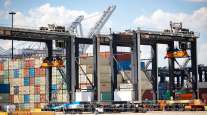Senior Reporter
Ports Off to a Strong 2019 Start, but Concern Looms Over Trump Tariffs

Many of the nation’s ports have reported record monthly and quarterly container volumes so far in 2019, but port executives are expressing concern that steeper tariffs on Chinese goods imposed by President Donald Trump could hurt the economy — and their facilities.
The Port of Los Angeles just had the busiest April in its 112-year history moving nearly 736,466 20-foot equivalents, or TEUs, a 4.4% increase from 705,535 last year. Year to date the port — the nation’s busiest — is up 4.5% compared with 2018.
April 2019 was the busiest April in #PortofLA history—up 4.4% from April 2018. Volumes reached 736,466 TEUs last month. https://t.co/NQpZcZMflj pic.twitter.com/Wt4qKyMBoK — Port of Los Angeles (@PortofLA) May 9, 2019
“Despite heightened uncertainty in global trade, we continue to invest and prepare our infrastructure and services to provide the best value for our customers,” Executive Director Gene Seroka said in a statement.
At the nearby Port of Long Beach, the nation’s No. 2 port reported a nearly 1.6% year-over-year increase in container volume, moving 628,121 TEUs compared with 618,438 in April 2018. The port moved 1.8 million TEUs during the first quarter, making it the second-busiest first quarter in its history.
INFRASTRUCTURE WEEK: Ports Offer Ample Opportunity for P3s, Experts Say
Still, Executive Director Mario Cordero acknowledged in a press release the trade uncertainty caused by the tariffs.
“With warehouses full from shippers rushing to beat the looming threat of escalating tariffs, shipments slowed somewhat,” said Cordero. “It’s going to take some time for inventory to cycle to markets and typical growth to resume.”
On May 10, the Trump administration raised tariffs on $200 billion in Chinese imports to 25% from 10% after charging that China backtracked on commitments it made earlier in ongoing trade negotiations that have, at times, gotten testy.
Experts warned that the potential costs of Trump’s strategy could permeate throughout the U.S.
“A tariff is a tax — I think that sometimes gets lost in the discussion,” Paul Bingham, an economist with IHS Markit, told Transport Topics. “A tariff is not something that is physically paid in a foreign country by a foreign entity; it’s paid by whoever had imported that good. So, in a way it’s like a sales tax that is being applied to goods — but only categories from certain countries — and then people buy less of those goods.”
Speaking on Fox News, Larry Kudlow, the head of the president’s National Economic Council, acknowledged that U.S. businesses and consumers will feel the pinch of higher prices for goods imported from China. “Both sides will suffer on this,” he said.
It was not immediately clear when negotiators from both nations might resume talks, but the American and Chinese presidents are expected to meet at the next G-20 summit in Osaka, Japan, June 28-29.
There’s a lot at stake in those discussions for the Port of Oakland — the facility called China its “largest trading partner” in a news release announcing April container volume. The facility moved 216,000 TEUs that month, a nearly 5.9% increase compared with 204,015 in 2018. It was the busiest April in the port’s 92-year history.
Ports association expresses concerns over tariff increases; in coordination with other industry groups, AAPA opposes new tariffs on Chinese goods https://t.co/mTgjvzlALd #oakland #tariffs #AAPA_Seaports #maritime #trade pic.twitter.com/OmnTkeNNqO — Port of Oakland (@PortofOakland) May 10, 2019
“We entered this year with uncertainty over the trade outlook, so we’re gratified by the solid performance of import cargo,” Port of Oakland Maritime Director John Driscoll said. “At the same time, all of us involved in global trade are concerned about what comes next.”
The American Association of Port Authorities, a Washington, D.C.-based national trade association, expressed its worry over Trump’s tougher talk against Beijing.
“AAPA is very concerned about the president’s decision to increase tariffs on Chinese goods and the expected retaliatory actions by the Chinese government,” said Susan Monteverde, the group’s vice president of government relations. “We urge the president to put a pause on this action and continue negotiations. Tariffs harm all Americans as the increased cost of goods imported and exported are felt throughout our nation.”
For March, the Port of New York and New Jersey reported a 2.2% increase in total TEUs, to 585,098 compared with 572,576 a year ago. Volume during 1Q rose 6.7% to 1.792 million TEUs, compared with 1.680 million in 2018.
Georgia’s Port of Savannah had a strong March, loading 410,326 TEUs compared with 355,208 in 2018, a 15.5% increase. For the first quarter the Savannah facility is up 11.3% year-over-year, moving 1,152 million TEUs compared with 1,035 million in 2018.
The South Carolina Ports, which operate the Charleston facility, saw its TEU numbers tick upward 7.2% in March with 214,113 TEUs compared with 199,659 in 2018. For the quarter ending March 31, the port saw a strong 11.7% jump to 597,933 TEUs compared with 535,537 in 2018.




